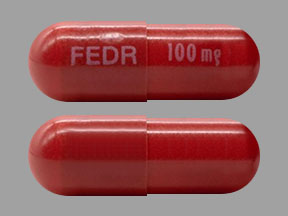Fedratinib Dosage
Medically reviewed by Drugs.com. Last updated on Oct 1, 2024.
Applies to the following strengths: 100 mg
Usual Adult Dose for:
Additional dosage information:
Usual Adult Dose for Myelofibrosis
For patients with a baseline platelet count of 50 x 10(9)/L or greater:
400 mg orally once a day
Comments:
- Patients who are taking ruxolitinib: Patients should taper off and discontinue ruxolitinib prior to starting this drug.
- Assess thiamine (vitamin B1) levels and nutritional status prior to starting therapy, periodically during therapy, and as indicated.
- Administration with a high fat meal may reduce the incidence of nausea and vomiting.
- Subsequent doses of this drug are subject to dose adjustments based on the concomitant use of CYP450 3A4 inhibitors, renal function, prior adverse reactions, and/or thiamine levels.
Use: For the treatment of patients with intermediate-2 or high-risk primary or secondary (post-polycythemia vera or post-essential thrombocythemia) myelofibrosis (MF)
Renal Dose Adjustments
Mild to moderate renal dysfunction (CrCl 30 to 89 mL/min): No adjustment recommended.
Severe renal dysfunction (CrCl 15 to 29 mL/min): Reduce the dose to 200 mg/day.
Liver Dose Adjustments
Mild to moderate liver dysfunction: No adjustment recommended.
Severe liver dysfunction (total bilirubin greater than 3 times the upper limit of normal [3 x ULN] and any AST): Not recommended.
Baseline liver function test levels should be obtained before starting treatment; levels should be obtained periodically and when clinically indicated throughout treatment.
Dose Adjustments
DISCONTINUATION OF TREATMENT:
- Treatment should be discontinued in patients unable to tolerate 200 mg/day.
DOSE MODIFICATIONS WITH CONCOMITANT USE OF STRONG CYP450 3A4 INHIBITORS:
- Reduce the dose of this drug when administering with strong CYP450 3A4 inhibitors to 200 mg orally once a day.
- If the strong CYP450 3A4 inhibitor is discontinued, increase the dose of this drug to 300 mg orally once d day during the first 2 weeks after discontinuation of the CYP450 3A4 inhibitor, and then to 400 mg orally once a day thereafter as tolerated.
DOSE MODIFICATIONS FOR HEMATOLOGIC ADVERSE REACTIONS:
- Consider dose reductions in patients who become transfusion-dependent during therapy with this drug.
- Grade 4 Thrombocytopenia or Grade 3 Thrombocytopenia with Active Bleeding: Withhold therapy until resolved to Grade 2 or less or baseline; restart at 100 mg/day below the last given dose.
- Grade 4 Neutropenia: Withhold therapy until resolved to Grade 2 or less or baseline, restart dose at 100 mg/day below the last given dose.
DOSE MODIFICATIONS FOR NONHEMATOLOGIC ADVERSE REACTIONS:
- Grade 3 or Higher Nausea, Vomiting, or Diarrhea Not Responding to Supportive Measures Within 48 Hours: Withhold therapy until resolved to Grade 1 or less or baseline; restart dose at 100 mg/day below the last given dose.
- Grade 3 or Higher ALT, AST, or Bilirubin: Withhold therapy until resolved to Grade 1 or less or baseline; restart dose at 100 mg/day below the last given dose; monitor ALT, AST, and bilirubin (total and direct) more frequently following the dose reduction.
- Discontinue therapy if a Grade 3 or higher elevation recurs
- Grade 3 or Higher Other Nonhematologic Toxicities: Withhold therapy until resolved to Grade 1 or less or baseline; restart dose at 100 mg/day below the last given dose.
MANAGEMENT OF THIAMINE LEVELS AND WERNICKE'S ENCEPHALOPATHY (WE):
- Assess thiamine (vitamin B1) levels and nutritional status prior to starting therapy, periodically during therapy, and as indicated.
- Do not initiate this drug in patients with thiamine deficiency; replete thiamine prior to therapy initiation and during therapy if thiamine levels are low.
- If WE is suspected, immediately discontinue therapy and initiate parenteral thiamine treatment.
- Monitor until symptoms resolve or improve and thiamine levels normalize.
Precautions
US BOXED WARNINGS:
ENCEPHALOPATHY INCLUDING WERNICKE'S:
- Serious and fatal encephalopathy, including Wernicke's, occurred in patients treated with this drug.
- Wernicke's encephalopathy is a neurologic emergency.
- Thiamine levels should be assessed in all patients prior to starting treatment, and then should be assessed periodically during treatment, as clinically indicated.
- This drug should not be started in patients with thiamine deficiency; thiamine should be repleted prior to initiating treatment.
- Treatment should be immediately discontinued and parenteral thiamine initiated if encephalopathy is suspected.
- Patients should be monitored until symptoms resolve and/or thiamine levels resolve.
CONTRAINDICATIONS:
- None
Safety and efficacy have not been established in patients younger than 18 years.
Consult WARNINGS section for additional precautions.
Dialysis
Data not available
Other Comments
Administration advice:
- This drug may be taken with or without food.
- If a dose is missed, the next scheduled dose should be taken the following day.
- Patients taking ruxolitinib before initiation of this drug should taper and discontinue according to the ruxolitinib prescribing information.
Storage requirements:
- Store below 86F (30C).
Monitoring:
Levels of the following should be obtained prior to initiation, periodically during therapy, and as indicated:
- GASTROINTESTINAL: Amylase and lipase levels
- GENITOURINARY: Creatinine
- HEMATOLOGIC: Complete blood count with platelets
- HEPATIC: Liver function tests
- METABOLIC: Thiamine (Vitamin B1) levels
- RENAL: BUN
Patient advice:
- Advise patients to speak to their healthcare provider if they become pregnant, intend to become pregnant, or are breastfeeding.
More about fedratinib
- Check interactions
- Compare alternatives
- Reviews (1)
- Side effects
- During pregnancy
- Drug class: multikinase inhibitors
- Breastfeeding
- En español
Patient resources
Other brands
Professional resources
Other brands
Related treatment guides
See also:
Further information
Always consult your healthcare provider to ensure the information displayed on this page applies to your personal circumstances.


